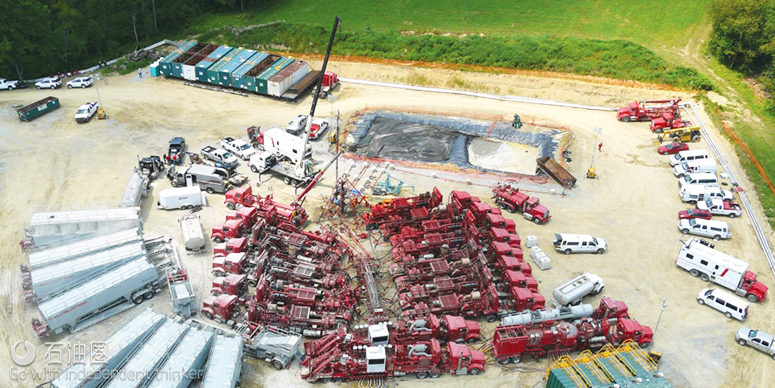Baker Hughes announced the commercial release of its Ascent high-side fracturing service. The Ascent fracturing service increases the conductive fracture area to improve recovery in stimulated wells compared to conventional fracturing techniques. This service incorporates specialized modeling, pumping techniques and proppant technology to create and maintain open fractures above the lateral wellbore.
Elevate production with more propped fracture area
“A common approach to generating more production from stimulated wells is to enlarge the fracture area by pumping greater fracturing fluid volumes.” says Scott Nelson, production enhancement director, Baker Hughes Pressure Pumping. While higher sand and fluid volumes may push the fracture out further into the reservoir, the additional treatment expense often fails to deliver an equivalent production increase.
This is because, with conventional sand and low viscosity fracturing fluids, placing proppant above the horizontal lateral is extremely difficult. Instead, most of the sand creates “dunes” in the lower portion of the well and any sand that might reach above the lateral wellbore typically falls before the fracture closes. As a result, much of the fracture operators pay to create is lost when the unpropped fractured area seals.
Produce more…from more of your reservoir
There are more efficient ways to improve your fracture network and production potential. The Ascent service’s ultra-lightweight proppants establish clear flow paths into more of the created fracture network area—including the area above the wellbore—to deliver better production from more of your reservoir.
The service combines advanced modeling and specialized pumping techniques, and leverages strong, ultra-lightweight proppant technologies to create and maintain open fractures above the lateral wellbore that cannot be effectively propped through conventional low-viscosity fluid treatments.
As an added benefit, overall proppant and water volumes, along with related transportation and pumping costs, are minimized without negatively impacting production.
Unlike conventional fracturing fluid applications, in which proppant often fails to remain in the high-side of the fracture network, the Ascent fracturing service leverages advanced modeling and strong, ultra-lightweight proppant technology with a specific gravity near that of water. The Ascent fracturing service keeps the proppant in place above the lateral wellbore even after pumping has concluded and the formation begins to close, propping open those hydrocarbon pathways and ensuring access to more potential production—even in formations with extended closure times. Additionally, because the service transports the proppant using extremely low polymer loading, the risk of gel residue restricting hydrocarbon flow through the proppant pack is virtually eliminated. The Ascent fracturing service’s specialized pumping techniques helps achieve these benefits while also reducing water usage and proppant volumes along with their related costs.
“Because hydraulic fracturing represents a significant portion of unconventional well construction cost, it’s critical for customers to produce hydrocarbons cost-effectively from as much of their fracture network as possible,” said Douglas Stephens, president, pressure pumping at Baker Hughes. “The new Ascent fracturing service uses specialized technologies and pumping techniques to help our customers lower their cost per barrel by producing hydrocarbons that otherwise would have remained trapped in the formation above their laterals.”
Features and benefits
Better proppant distribution across the fracture network, increases conductive fracture area; places proppant above the lateral; reduces BOE costs by utilizing more of the reservoir’s conductive potential; slows decline rates.
Strong, ultra-lightweight proppant technology, generates highly conductive fractures; expands propped fracture area on the high side of the fracture; delivers optimized, effectively placed stages ; improves reservoir recovery rates.
Improves fluid and proppant efficiency, reduces multistage stimulation times; minimizes operational costs and health, safety & environment (HSE) footprint.
“The Ascent service incorporates advanced proppant technology, as well as several best practices developed and refined over the last few years,” Nelson says. “In order to demonstrate the increased production and better efficiency achieved with the Ascent service, Baker Hughes did some data mining to find older jobs that met the service criteria, then compared those wells to nearby offsets to quantify the performance.”
Application
High-side proppant placement in: Ascent high-side
1.Unconventional plays;
2.Conventional reservoirs.
Case: Barnett Shale, Texas
In a 19-well, 36-month production study, the Ascent™ high-side fracturing service helped operators increase hydrocarbon recovery by an average of 117% compared to other wells of a similar depth and length located within a 2 mile radius. The offset wells were stimulated using conventional techniques and fluid designs.
In addition, the Ascent wells lowered the operators’ water and proppant usage. Water usage decreased 20% from 1,543 gal/ft. in the offsets to 1,223 gal/ft. in the Ascent wells. Total proppant volumes were comparable with an average of 484 lbs/ft in the conventionally treated slickwater and sand wells and 476 lbs/ft in the Ascent wells. The Ascent wells’ production rate was more than double that of the offset wells-indicating a significantly greater conductive fracture area due to the placement of proppant above the horizontal lateral wellbore.


 石油圈
石油圈
